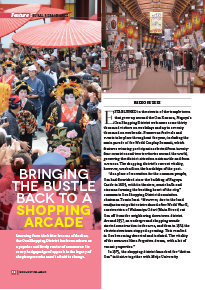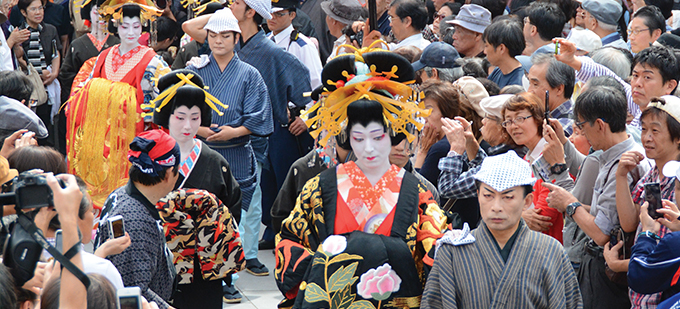Home > Highlighting JAPAN >Highlighting Japan June 2015>Rural Renaissance
Highlighting JAPAN

Rural Renaissance
Bringing the Bustle Back to a Shopping Arcade
Learning from the bitter lessons of decline, the Osu Shopping District has been reborn as a popular and lively center of commerce. Its saucy hodgepodge of appeals is the legacy of shopkeepers who aren’t afraid to change.

Established in the streets of the temple town that grew up around the Osu Kannon, Nagoya’s Osu Shopping District welcomes some thirty thousand visitors on weekdays and up to seventy thousand on weekends. Numerous festivals and events take place throughout the year, including the main parade of the World Cosplay Summit, which features winning participants selected from twenty-four countries and two territories around the world, garnering the district attention nationwide and from overseas. The shopping district’s current vitality, however, was built on the hardships of the past.
“As a place of recreation for the common people, Osu had flourished since the building of Nagoya Castle in 1609, with its theaters, music halls and cinemas forming the bustling heart of the city,” comments Osu Shopping District Association chairman Tomio Imai. “However, due to the land readjustment policies introduced after World War II, construction of Wakamiya Odori (Main Street) cut Osu off from the neighboring downtown district. Around 1957, an underground shopping arcade started construction in the area, and then in 1974 the electric streetcars stopped operating. This resulted in Osu becoming deserted and isolated. The vitality of the area was like a forgotten dream, with a lot of vacant properties.”
In 1975, the shopping district launched the “Action Osu” initiative together with Meijo University students and professors over concerns for the area. Over forty entertainers performed at approximately fifteen venues in the shopping district, designed to draw visitors to every nook and cranny of Osu. The strategy was a success, and marked the beginning of the area’s resurgence.
The Ameyoko Building, completed in 1977, gave people a place to shop for inexpensive electronic products. That same year the Tsurumai subway line began operations, allowing visitors access to both the eastern and western extremities of Osu. The combination of mass-market consumer electronics with a common touch lured people back to the district, including the younger generation. With the creation of an Osu Shopping District map, the availability of personal guides for weekend visitors, and the installation of updated electronic payment systems in conjunction with the Aichi World Expo in 2005—as well as nine AED stations placed throughout the area—both service and security have continued to improve by leaps and bounds.
“When you stop walking, you fall into deterioration,” Imai declares. “We want to constantly move forward.” The Osu Shopping District has an adaptive spirit, changing products to keep up with the times and welcoming new young entrepreneurs—even from overseas—to come open shops. This attitude is not only an indigenous characteristic of Osu, but also based on hard lessons learned from the struggle to survive during the district’s inactive period.
The Osu Street Performers Festival celebrates its thirty-seventh year in October 2015. Started as part of the “Action Osu” initiative, the vastly popular event welcomes over three hundred thousand people each year. The event's planning committee members are limited to a one-year term, and are selected from among the district’s younger shop owners. With its media attention and some eleven hundred shops involved, the festival endeavors to convey the Osu Shopping District’s hodgepodge appeal. The “hodgepodge” image reflects the district’s chaotic mix—the intangible, fun experience shared among the young, the old, otaku (geeks) and people from different cultures alike.
The Osu Shopping District has seen increasing numbers of overseas tourists in recent years, particularly from Asia. Its webpage and guide maps have been translated into multiple languages, and plans are afoot to apply for duty-free status for the entire district. Perhaps overseas visitors, too, are drawn in by the fascinating mix of traditional Japanese shops side by side with maid cafes, computer stores and cosplay outfitters. As the people of the district constantly innovate and embrace change, their enthusiasm can be appreciated from around the world.
© 2009 Cabinet Office, Government of Japan






